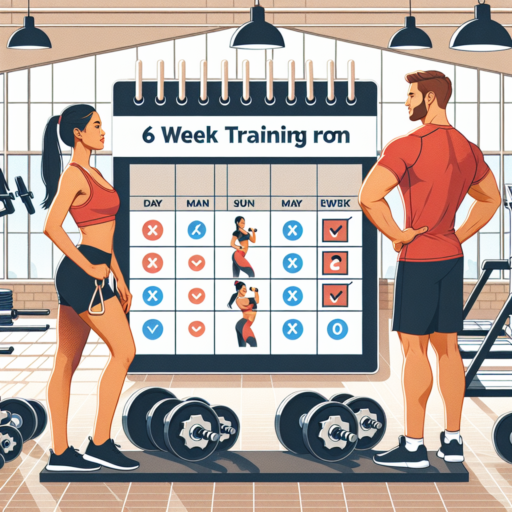Introduction to Intermediate Workout Schedules
When transitioning from beginner to intermediate workout schedules, it’s crucial to understand the importance of properly structured routines. These schedules are designed not only to increase physical challenge but also to focus on balanced development, targeting different muscle groups effectively. Intermediate schedules introduce more complex exercises and combinations, pushing the body’s tolerance and endurance to new levels.
At this stage, consistency and progression play pivotal roles. Progression doesn’t mean simply increasing the weights; it also encompasses enhancing technique, form, and the understanding of each exercise’s purpose. An intermediate workout schedule includes a mix of strength training, cardio, and flexibility exercises, distributed throughout the week to ensure adequate recovery times between workouts targeting the same muscle groups.
Familiarizing oneself with new exercises and routines is essential. It’s recommended to incorporate a variety of training methodologies such as supersets, drop sets, or pyramid training to overcome plateaus. Moreover, intermediate athletes should focus on fine-tuning their diet and recovery processes to support the increased demands of their workout schedules.
Key Components of an Effective Intermediate Training Program
An effective intermediate training program strikes the balance between challenging and achievable, pushing individuals to new heights while solidifying their foundational skills. At this stage, specificity and progression are paramount to ensure ongoing engagement and prevent plateaus. Understanding the core components that underpin such a program can significantly impact its success.
Progressive Overload
Progressive overload is the cornerstone of any successful training regime, particularly at the intermediate level. It involves gradually increasing the intensity, volume, or frequency of an exercise to challenge the body and promote growth. For intermediate trainees, it’s crucial to introduce variations in exercises and increment resistance to continuously stimulate muscle adaptation without causing injury or exhaustion.
Periodization
A well-structured program incorporates periodization, dividing the training schedule into phases. Each phase focuses on different goals, such as building muscle mass, enhancing endurance, or refining technique. This strategic variation not only prevents boredom and overuse injuries but also primes the body for peak performance by optimizing recovery and adaptation periods. It allows intermediate athletes to progress systematically, breaking through performance plateaus and achieving new personal bests.
Recovery and Nutrition
No training program is complete without a focus on recovery and nutrition. Adequate rest and a balanced diet fuel the body’s repair process, supporting muscle growth and reducing the risk of injuries. Intermediate trainers should prioritize sleep, incorporate active recovery days into their routines, and ensure their diet is rich in essential nutrients to sustain the increased demands of their training program.
Weekly Workout Schedule for Intermediate Athletes
When it comes to optimizing your performance and ensuring consistent progress, having a structured Weekly Workout Schedule for Intermediate Athletes is essential. This plan is designed to balance intensity, recovery, and variety, pushing you towards your fitness goals while minimizing the risk of overtraining or injury.
For intermediate athletes, it’s crucial to focus on both strength and conditioning components throughout the week. This ensures all major muscle groups are targeted effectively, promoting balanced development and reducing the likelihood of muscle imbalances. Incorporating varied training modalities can also prevent plateauing, keeping both your mind and body engaged.
Key Components of the Schedule
- Strength Training: Dedicate at least three days to strength training, focusing on compound movements (such as squats, deadlifts, and bench presses) to engage multiple muscle groups simultaneously. This approach builds strength and stimulates muscle growth efficiently.
- Cardiovascular Workouts: Incorporating two days of cardio ensures you maintain a healthy heart and improve your overall endurance. These sessions can vary between steady-state and high-intensity interval training (HIIT) to maximize fat loss and cardiovascular health.
- Flexibility and Recovery: Do not overlook the importance of flexibility and recovery sessions. Integrating activities like yoga or Pilates, along with at least one full rest day, is crucial for allowing your muscles to recover, adapt, and grow stronger.
Strength Training Focus for Intermediate Levels
Reaching an intermediate level in strength training symbolizes a significant milestone in an individual’s fitness journey. At this stage, the focus shifts towards more specialized goals, necessitating a deeper understanding of exercise selection, volume, and intensity. The primary objective is to build upon the foundation laid during the beginner phase, advancing in both strength and muscle development.
Optimizing Exercise Selection
Intermediate lifters should prioritize compound movements that recruit multiple muscle groups, such as squats, deadlifts, bench presses, and pull-ups. Incorporating these exercises helps maximize strength gains and efficiency in workout routines. It’s crucial, however, to also include accessory exercises to target weaker or underdeveloped areas, ensuring balanced muscular development and reducing the risk of injury.
Adjusting Volume and Intensity
An intricate balance of volume (the total amount of work done) and intensity (the level of effort applied) becomes vital for continuous advancement. Intermediate lifters are encouraged to gradually increase the weight lifted while carefully monitoring their body’s response to avoid overtraining. Implementing periodization strategies, by cycling through phases of higher volume and lower intensity, followed by phases of higher intensity and lower volume, can optimize strength gains and aid in recovery.
Understanding the nuances of strength training at an intermediate level is imperative for sustained progress. By focusing on effective exercise selection and fine-tuning the balance between volume and intensity, intermediate lifters can pave the way towards achieving their strength and physique goals. Emphasizing these elements ensures a structured and effective approach to continuing the strength training journey.
Cardiovascular Training in an Intermediate Workout Plan
Integrating cardiovascular training into an intermediate workout plan is essential for those looking to enhance their aerobic capacity and overall fitness levels. This stage of exercise programming is crucial as it builds upon the foundations laid during beginner phases, pushing the body to adapt to more challenging demands. Cardiovascular exercises, ranging from brisk walking to running, cycling, and swimming, play a pivotal role in improving heart health, increasing stamina, and promoting fat loss.
When mapping out an intermediate workout plan, the inclusion of cardiovascular training should be strategic. It’s about balancing intensity, duration, and variety to avoid the pitfalls of overtraining or hitting a plateau. At this level, individuals are encouraged to experiment with different cardio formats, such as High-Intensity Interval Training (HIIT) or steady-state cardio, to find what best suits their goals and preferences. This approach ensures that the heart and lungs are consistently challenged, fostering improvements in cardiovascular efficiency and endurance.
Moreover, understanding the importance of rest and recovery is paramount in an intermediate workout plan. Implementing cardiovascular training should not overshadow the necessity for adequate rest periods. This equilibrium between exercise and recovery is key to achieving sustainable progress and preventing injuries. By prioritizing a balanced workout schedule that includes both cardiovascular training and strength exercises, individuals can enjoy a well-rounded fitness journey that enhances both their physical and mental well-being.
Importance of Flexibility and Mobility Work for Intermediates
Enhancing Performance and Progression
For intermediate athletes, incorporating flexibility and mobility work into their routine is crucial for advancing to higher levels of performance. While basic exercises and strength training form the foundation, flexibility and mobility work fine-tune the body’s ability to perform more complex movements. These practices not only improve the range of motion but also prevent the plateau effect seen in many training programs, ensuring continuous progression and improvement.
Reduction of Injury Risks
Another significant aspect of including flexibility and mobility exercises in an intermediate fitness regime is the substantial reduction in injury risks. As the intensity and complexity of workouts increase, the body’s vulnerability to injuries also rises. Regular flexibility and mobility training strengthens the joints, ligaments, and muscles, making them more resilient to the stresses of rigorous exercise. This means fewer setbacks and consistent training progress.
Optimizing Recovery Processes
Lastly, flexibility and mobility work play an essential role in optimizing recovery processes. For intermediates, recovery is as vital as the workout itself. Enhanced flexibility improves blood circulation, facilitating quicker recovery by accelerating the removal of toxins and reducing soreness after intense sessions. Consequently, individuals can maintain a higher frequency of training, driving superior gains in strength and endurance.
No se han encontrado productos.
Sample Intermediate Workout Schedule to Follow
Following a structured workout schedule is critical for those at an intermediate fitness level who strive to enhance their physical capabilities. An effective plan involves a blend of various training styles to challenge the body, improve strength, endurance, and flexibility. This sample schedule is designed to be balanced and sustainable, incorporating essential elements of fitness to promote overall health and progress.
Strength Training
Incorporate strength training into your routine three times per week, focusing on compound exercises such as squats, deadlifts, presses, and rows. These movements engage multiple muscle groups, offering a comprehensive strength-building session. Aim for moderate to heavy weights where you can perform 3-4 sets of 6-12 reps with good form.
Cardiovascular Training
Cardiovascular training is paramount for heart health and stamina. Integrate at least three cardio sessions weekly, where two days are moderate-intensity steady-state (MISS) exercises like jogging or cycling for 30-45 minutes. Dedicate one day to high-intensity interval training (HIIT) for 20-30 minutes to maximize fat burning and improve metabolic health. Balancing the intensity of your cardio sessions ensures that you’re not overtraining and allows for ample recovery between workouts.
Active Recovery
Active recovery days are crucial in any intermediate workout schedule. These days should include activities that promote muscle recovery and flexibility, such as yoga, light jogging, or dynamic stretching sessions. Incorporating one to two active recovery days per week aids in reducing soreness, improving mobility, and ensuring your body is prepared for the next workout session.
Adjusting Your Workout Routine for Optimal Results
When it comes to enhancing your fitness journey, adjusting your workout routine is essential for achieving and maintaining optimal results. This means regularly evaluating and modifying your exercise regimen to keep your body challenged and progressing. Understanding the importance of variation in your exercises not only prevents boredom but also ensures that all muscle groups are being effectively worked.
Why Adjust Your Routine? Over time, our bodies become accustomed to the stresses we regularly place upon them. This adaptation leads to a plateau in progress, making changes in your routine necessary for continued improvement. Incorporating different types of workouts, adjusting the intensity, and varying the duration can help overcome these plateaus. For instance, if your routine has heavily focused on cardio, introducing strength training can provide a fresh challenge and balance to your fitness regimen.
Incorporating a mix of exercise styles and intensities is crucial for holistic physical development. Techniques such as interval training, circuit training, and flexibility exercises, when added or rotated into your routine, can dramatically improve your strength, endurance, and mobility. Adjusting your workout not only revitalizes your training sessions but also mitigates the risk of overuse injuries, ensuring a healthier and more sustainable fitness journey.
Nutrition and Recovery Strategies for Intermediate Training
Intermediate training demands a strategic approach to nutrition and recovery to ensure consistent progress and prevent injuries. The intricacies of fueling your body correctly and adopting the right recovery techniques can significantly enhance your training outcomes. It’s pivotal to understand the symbiosis between nutrition, recovery, and training intensity to craft a regimen that propels you toward your fitness goals.
The Role of Macronutrients in Recovery
Macronutrients – carbohydrates, proteins, and fats – play a crucial role in your recovery process. Carbohydrates are essential for replenishing glycogen stores depleted during exercise, which is critical for endurance and the ability to maintain intensity throughout your training sessions. Proteins are the building blocks of muscle repair and growth, making them indispensable for recovery after rigorous training. Including an adequate amount of fats in your diet supports hormone function and overall health, further aiding the recovery process. Balancing these macronutrients according to your training intensity and goals is a key aspect of an effective nutrition strategy.
Optimizing Recovery Techniques
Beyond nutrition, embracing a comprehensive recovery strategy is fundamental. Active recovery, involving low-intensity physical activities on rest days, promotes blood circulation and muscle repair. Equally, ensuring adequate sleep each night is paramount, as it facilitates physiological recovery and muscle regeneration. Incorporating practices such as hydration, stretching, and mindfulness activities can further optimize the recovery process, helping you to prepare both mentally and physically for your next training session.
Tracking Progress and When to Adjust Your Intermediate Workout Schedule
Understanding when and how to adjust your intermediate workout schedule is crucial to avoid hitting a plateau and to continue making progress. Tracking your fitness journey effectively helps in identifying when a change is needed. It’s not just about increasing the weight or changing the exercises; it’s about being mindful of your body’s responses and performance enhancements.
To effectively track progress, consider noting down the specifics of each workout session, including the exercises performed, weights lifted, sets and repetitions, and even how you felt during and after the session. This documentation can highlight patterns of improvement or stagnation, indicating when it might be time to tweak your routine. Regular fitness assessments, such as testing your one-rep max or measuring your body composition, offer concrete data to guide these adjustments.
So, when should you consider adjusting your intermediate workout schedule? Key indicators include a lack of progression in strength or endurance, increased fatigue, or a loss of motivation. When you notice these signs, it might be time to introduce new exercises, alter your set and repetition scheme, or adjust your rest periods. Implementing these changes can help reignite your workout performance and enthusiasm.




